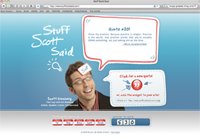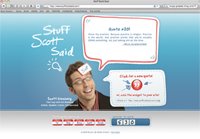 The best way to win the game is to change the way it’s being played.
The best way to win the game is to change the way it’s being played.
That’s how you dwarf the competition.
That’s how you reach the people who matter.
That’s how you solidify your place in the history books.
AND THE SECRET IS: It not important what game you change.
It’s important why you want to change it.
It’s important who you become while you change it.
It’s important how the world improves once people start to play.
Are you ready to roll the dice?
Consider these ideas for being a game changer:1. Provide an alternate platform. Hulu changed the television game twice. First, in 2007. Their website began offering ad-supported streaming video of shows and movies from NBC, Fox, ABC and later Disney.
And viewers could watch their favorite shows, anytime, anywhere – for free. Lesson learned: Find out where the door is already revolving. Then let the wind carry you across the threshold.
The second game-changer occurred three years later when they launched Hulu Plus, the first ad-supported subscription service to offer full current season runs of hit programs across multiple Web-connected devices. According to CEO Jason Kilar, “With Hulu Plus – your favorite TV shows love you back.”
Lesson learned: Don’t fight the current. Match your deliverables with your people’s preferred channel. Ultimately, you have to remember that your customers are making music already. The question is: When are you going to join their drum circle, and what type of instrument will you bring?
2. Change the interaction model. I contribute to around fifty different publications, both online and offline. And as a writer and speaker, doing so is essential element of my visibility plan and a crucial component to my listening platform.
What’s more, the reader interaction model I’ve created makes my editors love me. Here’s how: Each of my modules concludes with a unique response mechanism, or call to action.
It’s become a trademark of my writing style and a calling card of my brand. And it’s helped me change the writer/reader game, albeit on a small scale. Inspired by Scott Adams’ idea to include his email address on every Dilbert cartoon, my daily posts take it one step further.
Not only do I give people my email – I offer them an additional resource to supplement the piece of content they just read, watched or listened to. The cool part is, the bonus resource changes every time. There must be hundreds of lists. All of which are free for anybody.
And every day, I receive thirty to fifty emails from readers worldwide who not only want the list – but also want to offer feedback on the piece of content they just read. Which, I later feed back to my editor. Which, they love.
Result: The readers win. The writer wins. The publisher wins. How are you interacting with your people in a way nobody else is?
3. Blow the barriers to powder. Jason Fried is the cofounder and president of Chicago-based collaborative Web-application company, 37signals. He’s also the author of my favorite book of the year, Rework.
“Getting real is less. Less mass, less software, less features, less paperwork, less of everything that’s not essential. And most of what you think is essential actually isn’t.”
Love it. Love it. Love it. Now, the reason Jason’s a game changer is because his software company sells a suite of web tools architected around open-source programming frameworks. According to his interview with Timeout:
“When you lower the barriers of entry, powerful applications (that formerly might have taken months) are executed in a matter of days.”
Lesson learned: To change the game, first pave the way for a new era of players. What about you? How will your organization make it easier for people to participate in your process?
After all, it’s not about technology – it’s about extending usability to new industries. And you don’t need to write software – you just need to surrender a little control. How are you enabling people to take your idea into their own hands?
4. Tip the balance of power. My friends at Brains on Fire have been changing the customer engagement game for years. In their eponymous book, authors Gino Church, Robbin Phillips and Greg Cordell write:
“Participate in people’s lives – not just the conversation about their lives. Because it’s not about you talking about your product. It’s about people celebrating how your product fits into their lives and how you enable them to use it.”
That’s how you tip the balance of power: By asking your fans how they prefer to connect. By giving fans the ability to participate in your message. Otherwise you’re just in love with your own marketing. The door opens both ways.
Like my mom once told me, “Always doing just what you want and making the decisions unilaterally is a sure fire path to destruction.” How are you deeply engaged with your people?
5. Change the basic metabolism. That’s how YouTube trumped television: It was no longer just about watching the videos. Now it was about uploading, sharing, rating, tagging and cataloguing the videos. As a result, they transformed the entire medium. They changed the basic metabolism.
If you want to execute the same for your organization, I challenge is to rethink the way people consume. Take mobile content, for example. Remember when cell phones were used to make phone calls? Pshht. Thing of the past.
Now, because of hyper-connectivity and built-in payment options, the game has changed. Cell phones are no longer cell phones – they’re pocket portals into people’s lives. Not to mention, their wallets.
And if you’re not befriending that current, the crumbled remains of your message will wash up along the mobile shore. Are you trying to put books on people’s shelves or people value in people’s pockets?
6. Become fans of your fans. Take Pearl Jam, for example. After twenty years of rocking, they no longer care about the labels. Or the radio stations. Or the record stores.
All that matters is the music. Giving the fans that love it something to believe in, according to Eddie Vedder’s 2007 Rolling Stone interview. And not surprisingly, Pearl Jam has outlasted most of its grunge rock counterparts.
They’ve sold sixty million records worldwide, many of which were bootleg recordings of live shows to give people a chance to relive their concert experience. All because Pearl Jam was a fans of their fans.
Are you giving your people a reason to ditch the mainstream and follow you into the sunset? After all, love is a circular transaction, says the aforementioned Robbin Phillips. And if you want to change the game, you stop making war on the competition and start making love to your customers. Whose jersey are you willing to wear in public?
7. Access trumps ownership. Google eliminates the need to buy and own books. Pandora eliminates the need to buy and own music. YouTube eliminates the need to buy and own a television. Online storage removes the need to buy and own external hard drives.
That’s been the biggest cultural shift over the past five years: Nobody owns anything anymore. Everything you need is either available for free or shared for cheap. Like landlines and online privacy, owning things is a thing of the past.
“Consumers have more choices, more tools, more information, and more peer-to-peer power,” says Lisa Gansky, author of The Mesh:
“Smart companies create, share and use social media, wireless networks, and data crunched from every available source to provide people with goods and services at the exact moment they need them, without the burden and expense of owning them outright. And there is real money to be made and trusted brands and strong communities to be built in helping your customers buy less but use more.”
Take Zipcar, for example. They changed the game of personal transportation by making it easy and affordable to have a car whenever you need one, without actually owning one. Brilliant.
Therefore, because access trumps ownership, your challenge is twofold. First, to make friends with free. Identify which of the many models of free your organization is going to leverage. Otherwise The Rapture will leave you behind with the rest of the dinosaurs.
Second, deploy assets your customers don’t have to buy, but can easily access. By reducing the burden of ownership and offering wider access to your value, you can change the game forever. Are you (still) trying to charge customers for a cow they’re already milking electronically for free?
8. Shatter the limitations of size. Shawn Fanning never made a billion dollars creating Napster. But do you think he cares? Doubtful. His game-changing program became the pivot that altered the landscape of music industry for-better and for-always.
Screw making money – that guy made history. And he was just some dude in a dorm room. Who’s to say you couldn’t do the same?
Sure, it’s not probable that you’ll disrupt an entire industry. But it is possible. More possible than ever before. And that’s the great part about the Web: All that fluff you were force-fed as a kid about how one person could change the world has actually become a glimmering reality.
Advances in technology have (finally) made changing the game financially viable. I don’t know about you, but that’s the kind of thing that makes me get out – no, leap out – of bed in the morning. Do you think it’s time to pursue your goal with a more modern vehicle?
BOTTOM LINE: You can’t just sit there waiting for the revolution to begin.
You’ve got to extend your arm.
You’ve got to transform the tempo.
You’ve got to deploy an unconventional strategy.
You’ve got to shake people out of their complacencies.
You’ve got to blend the conventional with the contemporary.
You’ve got to carefully observe problems that fall through the cracks – then solve them.
That’s how you change the game.
LET ME ASK YA THIS…
What’s the nametag of your service process?
LET ME SUGGEST THIS…
For the list called, “12 Ways to Out Service the Competition,” send an email to me, and you win the list for free!
Scott Ginsberg
That Guy with the Nametag
Author, Speaker, Entrepreneur, Mentor
[email protected]
Watch The Nametag Guy in action here!


 You can’t force people to join your organization.
You can’t force people to join your organization. It’s not the noise.
It’s not the noise. “When you trust yourself, you learn how to live.”
“When you trust yourself, you learn how to live.” Who’s quoting YOU?
Who’s quoting YOU? Sing it with me:
Sing it with me: Sing it with me:
Sing it with me: Which one of the following questions dominates your daily decision-making?
Which one of the following questions dominates your daily decision-making? Who’s quoting YOU?
Who’s quoting YOU? I don’t care how brave you are.
I don’t care how brave you are. Who’s quoting YOU?
Who’s quoting YOU? A brand without focus is destined to be forgotten.
A brand without focus is destined to be forgotten. Not with a fatal disease, of course.
Not with a fatal disease, of course.